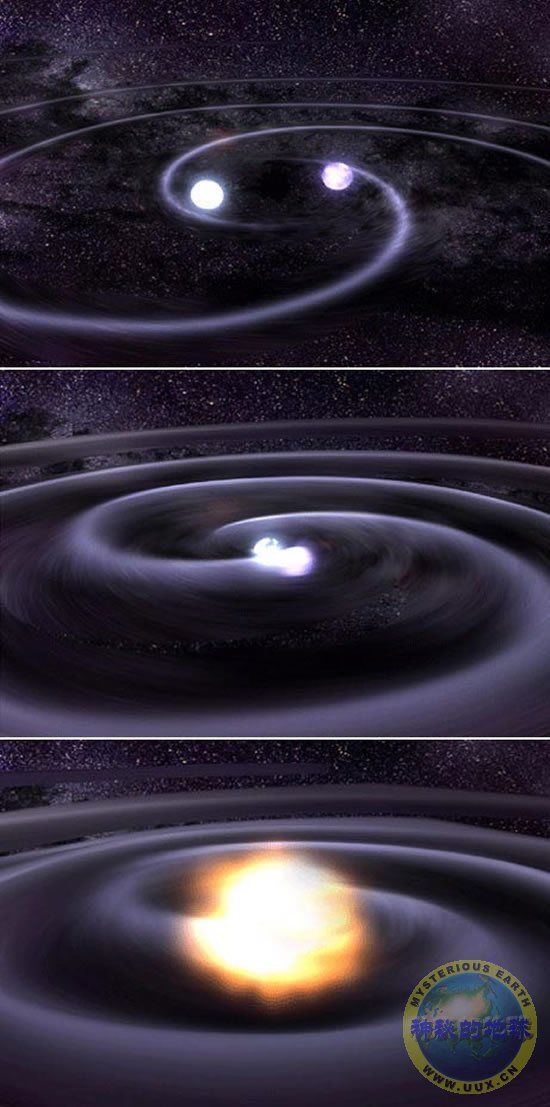Colliding Dead Stars Set Off Massive Supernova

Two white dwarfs—the cores left behind when stars similar to our sun die—spiral toward each other and trigger a supernova in an artist's conception.
A new study of the unusual supernova 2006gz provides the strongest evidence yet for the theory that merging white dwarfs can trigger stellar explosions.
John Roach
for National Geographic News
November 5, 2007
Two small but dense burned-out stars appear to have spiraled into each other and exploded, according to a new study.
The blast offers some of the strongest evidence yet for a theoretical model for supernovas created by white dwarfs—the hot cores left behind when stars similar to our sun die.
The finding could also have implications for studies of dark energy, a mysterious force thought to make up more than 70 percent of the universe.
Most white dwarf supernovas are believed to occur when the tiny dead stars siphon so much material from a larger, nearby star that they trigger a massive fusion reaction and explode.
The leading theory is that matter is being siphoned from a red giant—a type of star that is dying but not yet completely burned out.
The same explosion could also occur, however, if two white dwarfs merged, said Malcolm Hicken, an astrophysicist at the Harvard-Smithsonian Center for Astrophysics in Cambridge, Massachusetts.
Hicken and his colleagues now conclude that such a merger best explains the unusual properties of an extraordinarily bright supernova observed last year dubbed 2006gz.
The team's findings are described in the November 1 issue of the Astrophysical Journal Letters.
Stellar Merger
Current models classify supernovas as either Type I or Type II, the major difference being that only Type II blasts show evidence of hydrogen.
Astronomers had initially characterized supernova 2006gz—spotted 300 million light-years away in the constellation Hercules—as a Type Ia because it lacked hydrogen.
(See a picture of an unusual Type Ia supernova spotted on March 1, 2007.)
But closer observations suggested that 2006gz had other, unusual characteristics.
Most importantly, the supernova is surrounded by lots of unburned carbon, which theoretical models suggest should happen when white dwarfs merge, as well as compressed silicon.
The carbon forms an outer envelope around the supernova that acts like a wall.
Silicon blasted outward from the explosion ran into this envelope and bounced back, which created the layer of compressed silicon.
In a normal Type Ia explosion, there is no carbon wall, so any silicon present does not get compressed.
In addition, the supernova was brighter than expected, an indication that the star that created it had exceeded the upper mass limit for a lone white dwarf.
These three factors taken together suggest that "2006gz is the best evidence for two white dwarfs merging," Hicken said.
Andy Howell is an astrophysicist at the University of Toronto in Canada who was not involved in the new study.
In September 2006 he and his colleagues reported a supernova potentially created by a white dwarf merger in the journal Nature.
Howell said he is happy with the new study, which meets the criteria his team predicted for white dwarf mergers and suggests that his team's result was not an oddball.
"What this shows is that this is a class of things that happens all the time," he said.
Expanding Universe
The new finding, study author Hicken noted, could also have an impact on research related to the origins and nature of the universe.
In 1998 two independent teams using data from Type Ia supernovas discovered that the expansion of the universe is speeding up, most likely because of a substance called dark energy.
(See an artist's conception of how dark energy could eventually destroy the universe.)
That's because supernovas in the farthest reaches of space appear dimmer than they should if the universe is flying apart at a constant rate.
Since then astronomers have been using Type Ia supernovas to study dark energy and its role in cosmic expansion.
This model relies on the blasts having a standard brightness, based on the theory that most known Type Ia supernovas are created by white dwarfs siphoning material from companion red giants.
But if some Type Ia supernovas are formed from mergers and are brighter than others, it could throw off these calculations.
So far the two described white dwarf mergers have appeared so uncharacteristic that scientists discarded them from their dark-energy calculations, Hicken noted.
But the potential mergers were seen in star-forming regions of space, suggesting that astronomers may find more of these types of explosions as they peer further back in time when more star-forming galaxies existed.
"We have to be aware of [this] and make sure that we are excluding these objects that don't fit," Hicken said.
And Howell, of the University of Toronto, added that knowing more about white dwarf mergers could help astronomers easily discard Type Ia supernovas that fail to meet certain criteria.
Using such studies, he said, "we could actually make Type Ias better as [expansion] indicators."












